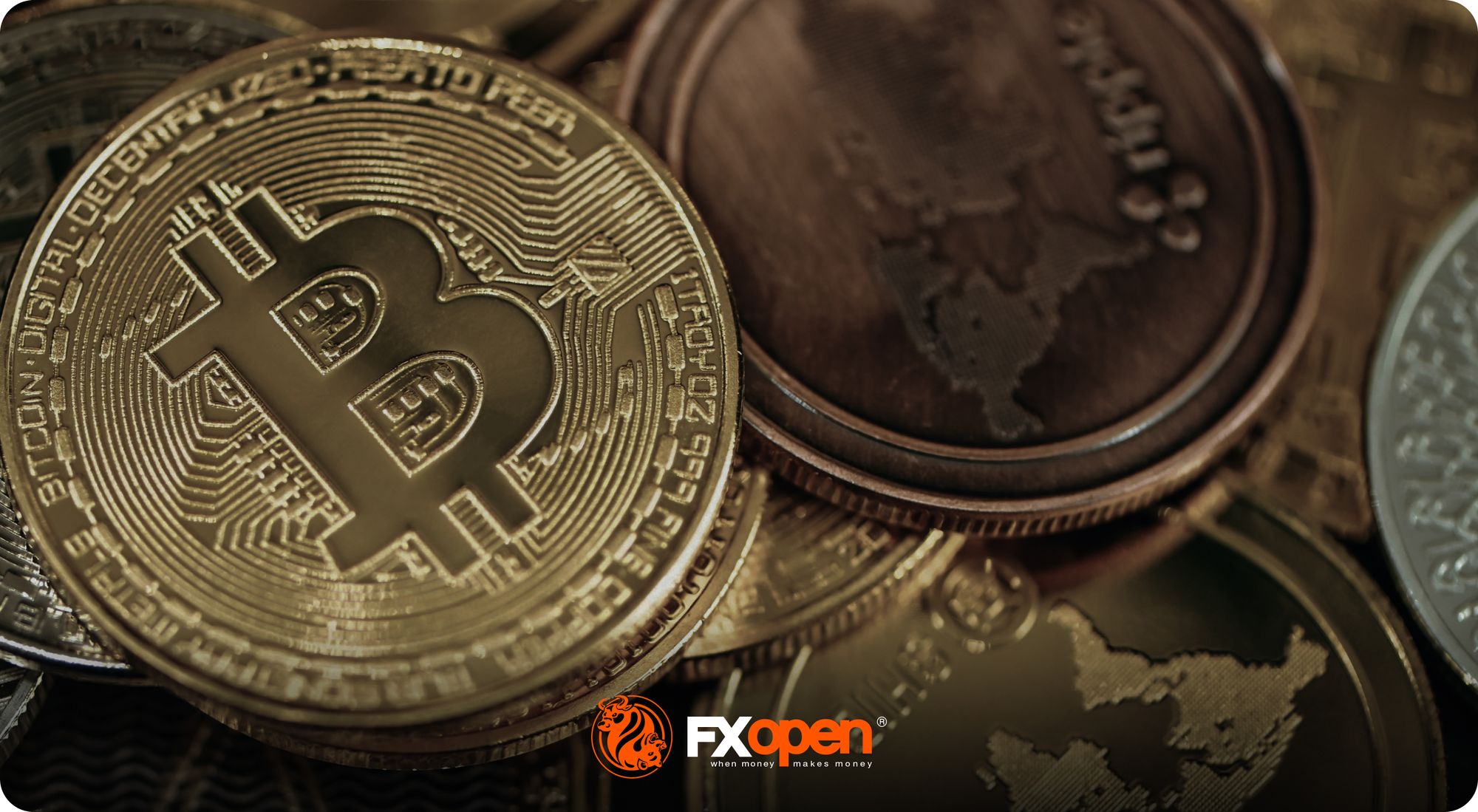FXOpen

A crypto bull run is an exciting period marked by rapidly rising prices and heightened market activity. Understanding what drives these price surges, such as Bitcoin halving events and institutional adoption, can help traders better navigate the crypto market. This article delves into the factors behind crypto bull runs, historical examples, and the potential risks involved.
Bull Run Meaning
A bull run is a period in the market where prices keep rising, creating an atmosphere of optimism and excitement. In cryptocurrencies, a bull run means that the prices of digital assets like Bitcoin or Ethereum are climbing steadily, often attracting more and more attention from traders and investors alike.
During a bull run, the market is fueled by a strong belief that prices will continue to rise. This belief can be driven by many factors, like positive news about the adoption of cryptocurrencies, big financial institutions getting involved, or even just a wave of enthusiasm across social media. As more people jump in, prices rise even higher, creating a self-reinforcing growth cycle.
But it’s important to remember that a bull run isn’t just about skyrocketing prices. It’s also about the broader sentiment in the market. Confidence is high, and people are generally optimistic about the future of the assets they’re trading or investing in. This can lead to a snowball effect, where more traders enter the market, pushing prices up further.
Drivers of Bull Runs in Crypto
A crypto bull run doesn’t just happen out of the blue. It’s usually the result of several key factors coming together to create a perfect storm of rising prices and market optimism. Here are some of the main drivers behind these powerful market movements.
Significant Positive News
One of the biggest drivers of a bull run is positive news. When traders and investors are optimistic, they’re more likely to buy and hold assets, pushing prices higher. This optimism can be sparked by events like favourable regulatory news, including a country embracing cryptocurrency, major partnerships, or endorsements from influential figures. When the mood is bullish, the market tends to follow.
Institutional Involvement
The entrance of large financial institutions into the crypto market can significantly impact prices. When big players like hedge funds, banks, or publicly traded companies start buying up digital assets, it sends a strong signal that cryptocurrencies are gaining legitimacy.
This influx of institutional money increases demand and liquidity, driving prices up and often triggering broader interest from retail investors. The 2020-2021 bull run, for example, was partly driven by companies like Tesla and MicroStrategy adding Bitcoin to their balance sheets.
Supply and Demand Dynamics
Supply and demand are fundamental to any market, and cryptocurrencies are no exception. Take Bitcoin, for instance, which has a capped supply of 21 million coins. As demand grows—whether due to increased adoption, media hype, or economic instability—prices tend to rise because there’s only so much Bitcoin to go around.
Similarly, Ethereum’s demand has been driven by the rise of decentralised finance (DeFi) and NFTs, pushing its price upward during bull runs. This scarcity effect can be a powerful driver of bull runs, especially as more people view cryptocurrencies as a hedge against traditional financial systems.
Bitcoin Halving Events
Bitcoin halving events are among the most significant factors driving crypto bull runs. A halving event occurs approximately every four years, reducing the reward for mining new blocks by 50%. This reduction in supply has historically led to increased scarcity, which can drive up prices if demand remains strong or grows.
So far, halving events have occurred in 2012, 2016, 2020, and most recently, 2024. Each time, a Bitcoin bull run has been triggered in the months or year following, helping to buoy the broader crypto market.
Macroeconomic Factors
Wider economic conditions can also play a crucial role. In times of economic uncertainty, such as high inflation or geopolitical instability, people often look for alternative assets to protect their wealth.
Cryptocurrencies, with their decentralised nature, can become particularly attractive. For example, during the COVID-19 pandemic, concerns about inflation and currency devaluation led many to explore Bitcoin as a "digital gold," contributing to its price surge.
Media and Social Influence
While not always a fundamental driver, media coverage and social media can amplify a bull run. Positive news stories, stories of extraordinary returns, endorsements from high-profile figures, and viral social media campaigns can create a sense of urgency and FOMO (Fear of Missing Out). This social buzz can push more people to buy into the market, further fueling the bull run.
Historical Examples of Crypto Bull Runs
Cryptocurrency bull runs have marked significant periods in the evolution of digital assets, each bringing its own set of dynamics and market behaviours. Let’s take a closer look at three major bull runs: 2017, 2020-2021, and the ongoing 2023-2024 cycle. Interested readers can examine the ebbs and flows of each cycle with FXOpen’s free TickTrader trading platform.
2017: The Retail Investor Frenzy
The 2017 bull run was a pivotal moment in cryptocurrency history. Bitcoin's price soared from around $1,000 in January to nearly $20,000 by December. This surge was largely driven by retail investors, many of whom were entering the market for the first time, fueled by the hype surrounding initial coin offerings (ICOs).
Ethereum also played a significant role in this run, as its blockchain became the foundation for numerous ICOs. However, this rapid growth was unsustainable, and by early 2018, the market experienced a severe correction, leading to what is often referred to as the "crypto winter," with Bitcoin’s price plummeting by more than 80%.
2020-2021: Institutional Adoption and Mainstream Attention
The next major bull run began in late 2020 and extended into 2021, with Bitcoin reaching new highs of nearly $69,000 in November 2021. This time, the market was driven by a different set of players—large institutions. Companies like MicroStrategy, Tesla, and Square made significant investments in Bitcoin, lending the asset a newfound legitimacy.
Additionally, the rise of decentralised finance (DeFi) and non-fungible tokens (NFTs) attracted even more interest and capital into the space. This period also coincided with the COVID-19 pandemic, where stay-at-home orders, economic stimulus packages, and low interest rates led to a resurgence of interest in cryptocurrencies.
Unlike the 2017 run, which was dominated by speculative retail activity, the 2020-2021 bull run was marked by a more mature market, with increased regulatory clarity and broader adoption across various sectors.
2023-2024: Bitcoin Bull Run and What’s Driving It
The Bitcoin bullish run that began in 2023 is shaping up to be another significant chapter in crypto history. After a brutal bear market in 2022, during which Bitcoin’s price dropped to around $15,500 as interest rates rose, the market began to recover in early 2023.
This recovery has been fueled by a resilient global economy, continued institutional adoption, technological innovations such as Layer-2 scaling solutions, and growing public interest in cryptocurrencies as a hedge against inflation and economic uncertainty.
Perhaps the most notable events driving the crypto bull run in 2024 were the approval of Bitcoin exchange-traded funds (ETFs) and Bitcoin halving in early 2024, which has historically triggered a bullish cycle. By March 2024, the BTC bull run saw it climb to a new all-time high of $74,000.
However, most other cryptocurrencies haven’t reached all-time highs. As of August 2024, the crypto market is correcting. The bull run is still expected in the near future.
The Role of Media and Social Influence
Media and social influence play a significant role in driving and shaping cryptocurrency bull runs. During these periods, news outlets, social media platforms, and influential figures can amplify market sentiment, creating a feedback loop that pushes prices even higher.
When mainstream media starts covering crypto positively, it often brings in a wave of new participants. For example, during the 2020-2021 bull run, widespread media coverage of Bitcoin’s rising prices and institutional investments helped draw in more retail investors. This exposure both increased market participation and validated cryptocurrencies as a legitimate asset class in the eyes of the broader public.
Social media, on the other hand, can be even more impactful. Platforms like X (Twitter), Reddit, and YouTube are where much of the crypto conversation happens in real-time. Influential voices, whether they’re market analysts or celebrity figures like Elon Musk, can move markets with a single tweet. For instance, Musk’s 2021 tweets about Dogecoin led to massive price surges and increased trading volume.
Moreover, communities on platforms like Reddit’s r/cryptocurrency and Discord channels contribute to the "FOMO" (Fear of Missing Out) that often drives people to buy in, further fueling a bull run. This blend of traditional and social media creates an environment where hype and optimism can quickly spread, propelling the market into a full-fledged bull run.
Potential Risks and Volatility During a Bull Run
While a bull run in crypto can be exciting, it’s essential to recognise the potential risks and volatility that come with it. During these periods of rapid price increases, the market can become difficult to analyse. Prices often surge quickly, but they can also fall just as fast, leading to significant financial swings for those involved.
One of the main risks in crypto bull run cycles is market overextension. As prices climb, more traders enter the market, sometimes without fully understanding the risks. This influx can inflate prices beyond sustainable levels, setting the stage for a sharp correction when the momentum slows down. History shows that such corrections can be severe; it’s not uncommon for lesser-known but still notable cryptocurrencies to fall as much as 95% from their all-time highs.
Volatility is another key concern. The crypto market is known for its significant price fluctuations, and during a bull run, this volatility can be amplified. A single piece of negative news or a sudden sell-off by large holders (whales) can trigger a rapid decline in prices, catching many traders off guard. News around regulatory action can also come out of the blue and severely damage sentiment, as was the case with the US Securities and Exchange Commission (SEC) filing a lawsuit against Ripple Labs, the creators of XRP.
Additionally, emotional trading driven by FOMO (Fear of Missing Out) can lead to irrational decisions, where traders buy at the peak, only to face losses when prices correct. Likewise, these irrational traders can be prone to selling quickly, leading to a self-reinforcing feedback loop that drives prices substantially lower.
The Bottom Line
Understanding the dynamics of a crypto bull run can help traders navigate the market more effectively. Consider opening an FXOpen account, where you can trade in rising and falling crypto markets via CFDs with spreads from 0.0 pips and low commissions from $1.50 per lot!
FAQ
What Is a Bull Run?
A bull run is a period during which prices in a financial market rise significantly and consistently over a sustained period. It's characterised by widespread optimism, increased trading volume, and a general belief that prices will continue to rise.
What Does Bull Run Mean in Crypto?
The bull run crypto meaning refers to a period when the prices of digital assets, like Bitcoin or Ethereum, experience rapid and sustained increases. This often attracts more traders and investors, leading to even higher prices and a strong market momentum.
How Long Did the Last Crypto Bull Run Last?
The last major crypto bull run began in late 2020 and peaked in November 2021. During this period, Bitcoin reached an all-time high of nearly $69,000, marking a bull run that lasted roughly a year.
When Is the Next Crypto Bull Run Expected?
Many see the crypto bull run in 2024 as the next bullish cycle, largely driven by increased crypto legitimacy, institutional adoption after Bitcoin ETFs were approved, global economic recovery, and the Bitcoin halving event. However, the exact timing of the next bull run currently remains unknown; historically, bullish crypto cycles occur every 3-4 years.
When Was the Last Crypto Bull Run?
The most notable recent cycle in crypto bull run history occurred from late 2020 to November 2021, driven by loose financial conditions, institutional adoption, the rise of decentralised finance (DeFi), and significant media coverage.
*Important: At FXOpen UK, Cryptocurrency trading via CFDs is only available to our Professional clients. They are not available for trading by Retail clients. To find out more information about how this may affect you, please get in touch with our team.
This article represents the opinion of the Companies operating under the FXOpen brand only. It is not to be construed as an offer, solicitation, or recommendation with respect to products and services provided by the Companies operating under the FXOpen brand, nor is it to be considered financial advice.
Stay ahead of the market!
Subscribe now to our mailing list and receive the latest market news and insights delivered directly to your inbox.








